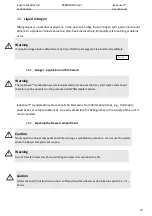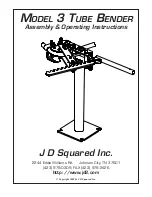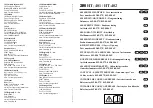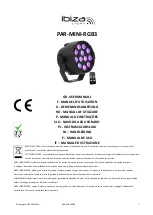
IceCure Medical Ltd.
DSR3000000 rev.L
Confidential
User Manual
20
IceSense3™
Liquid nitrogen containers should always be stored in an upright position.
Tipping the container or
letting it lie on its side can result in spillage and may damage the container. Dropping the container
or subjecting it to severe vibration may damage the vacuum insulation system.
Transfer liquid nitrogen with care.
Spilling and splashing are the primary hazards of transferring
liquid nitrogen from one container to another. NEVER overfill the containers. Filling above the
specified level is likely to produce spillage when the lid is replaced. Transportation of liquid nitrogen
must always be done in the original container and in accordance with local laws and safety rules.
Do not attempt to dispose of residual or unused quantities of liquid nitrogen.
For safe disposal
contact your supplier. For emergency disposal, discharge slowly to the atmosphere in a well-
ventilated room or outdoors.
If spilled liquid nitrogen causes a cloud to form, the room must be evacuated and ventilated
immediately. Anyone experiencing headache, dizziness, difficulty breathing, or other symptoms of
hypoxia should receive immediate medical attention.
Do not use a liquid nitrogen Dewar if it is damaged.
You can tell that a Dewar is damaged if after
filling it, frost appears on the outer wall of the container. Return the Dewar to an IceCure technician
or an authorized distributor for inspection.
Warning
Before beginning a procedure on a new patient, the Dewar
MUST
be completely filled and placed
in the system as described in section 5.2.7.1 of this manual.
2.4.5
Burn hazards
The Cryoprobe tip can reach very low temperatures.
Warning
Portions of the cryoprobe other than the freeze zone, including the plastic cover that is located
near the cryoprobe handle, may become cold and cause tissue damage. If unwanted freezing
occurs, stop the pre-test process by pressing "Cancel".
Warning
Portions of the cryoprobe other than the freeze zone, including the plastic cover that is located
near the cryoprobe handle, may become cold and cause tissue damage. If unwanted freezing
occurs, immediately stop the freezing process.
To prevent injury, cryoprobes must be closely observed during use for signs of unwanted freezing.
















































